eudicots
Tricolpates
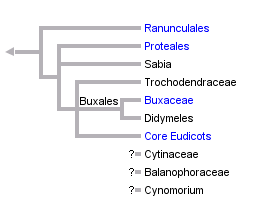


This tree diagram shows the relationships between several groups of organisms.
The root of the current tree connects the organisms featured in this tree to their containing group and the rest of the Tree of Life. The basal branching point in the tree represents the ancestor of the other groups in the tree. This ancestor diversified over time into several descendent subgroups, which are represented as internal nodes and terminal taxa to the right.

You can click on the root to travel down the Tree of Life all the way to the root of all Life, and you can click on the names of descendent subgroups to travel up the Tree of Life all the way to individual species.
For more information on ToL tree formatting, please see Interpreting the Tree or Classification. To learn more about phylogenetic trees, please visit our Phylogenetic Biology pages.
close boxReferences
Anderson, C. L., K. Bremer, and E. M. Friis. 2005. Dating phylogenetically basal eudicots using rbcL sequences and multiple fossil reference points. American Journal of Botany 92:1737-1748.
Carlquist, S. 1992. Wood anatomy of sympetalous dicotyledon families: a summary, with comments on systematic relationships and evolution of the woody habit. Annals of the Missouri Botanical Garden 79:303-332.
Donoghue, M. J. and J. A. Doyle. 1989. Phylogenetic studies of seed plants and angiosperms based on morphological characters. Pp. 181-193 in The Hierarchy of Life, ed. B. Fernholm, K. Bremer and H. Joernvall. Amsterdam; Elsevier Publ.
Doyle, J. A., M. J. Donoghue and E. A. Zimmer. 1994. Integration of morphological and rRNA data on the origin of angiosperms. Annals of the Missouri Botanical Garden 81:419-450.
Drinnan, A. N., P. R. Crane, and S. B. Hoot. 1994. Patterns of floral evolution in the early diversification of non-magnoliid dicotyledons (eudicots). Plant Systematics and Evolution 8 (Suppl.):93-122.
Endress, P. K. and A. Igersheim. 1999. Gynoecium diversity and systematics of the basal eudicots. Botanical Journal of the Linnean Society 130:305-393.
Hilu, K. W., C. Black, D. Diouf and J. G. Burleigh. 2008. Phylogenetic signal in matK vs. trnK: A case study in early diverging eudicots (angiosperms). Molecular Phylogenetics and Evolution 48(3):1120-1130.
Hilu, K. W., T. Borsch, K. Müller, D. E. Soltis, P. S. Soltis, V. Savolainen, M. W. Chase, M. P. Powell, L. A. Alice, R. Evans, H. Sauquet, C. Neinhuis, T. A. B. Slotta, J. G. Rohwer, C. S. Campbell, and L. W. Chatrou. 2003. Angiosperm phylogeny based on matK sequence information. American Journal of Botany 90(12):1758-1776.
Hoot, S. B. and P. R. Crane. 1995. Interfamilial relationships in the Ranunculidae based on molecular systematics. Plant Systematics and Evolution 9 (Suppl.):119-131.
Hoot, S. B., S. Magallón-Puebla, and P. R. Crane. 1999. Phylogeny of basal eudicots based on three molecular datasets: atpB and rbcL sequences, trnK restriction sites and morphological characters. Annals of the Missouri Botanical Garden 86:119-131.
Judd, W. S. and R. G. Olmstead. 2004. A survey of tricolpate (eudicot) phylogenetic relationships. American Journal of Botany 91:1627-1644.
Kim, S., D. E. Soltis, P. S. Soltis, M. J. Zanis, and Y. Suh. 2004. Phylogenetic relationships among early-diverging eudicots based on four genes: were the eudicots ancestrally woody? Molecular Phylogenetics and Evolution 31(1):16-30.
Magallón, S., P. R. Crane, and P. S. Herendeen. 1999. Phylogenetic pattern, diversity and diversification of eudicots. Annals of the Missouri Botanical Garden 86:297-372.
Nandi, O. I., M. W. Chase, and P. K. Endress. 1998. A combined cladistic analysis of angiosperms using rbcL and non-molecular data sets. Annals of the Missouri Botanical Garden 85:137-212.
Qiu, Y. L., J. H. Lee, F. Bernasconi-Quadroni, D. E. Soltis, P. S. Soltis, M. Zanis, E. A. Zimmer, Z. D. Chen, V. Savolainen, and M. W. Chase. 2000. Phylogeny of basal angiosperms: Analyses of five genes from three genomes. International Journal of Plant Sciences 161:S3-S27.
Savolainen, V., M. W. Chase, S. B. Hoot, C. M. Morton, D. E. Soltis, C. Bayer, M. F. Fay, A. Y. De Bruijn, S. Sullivan, and Y. L. Qiu. 2000a. Phylogenetics of flowering plants based on combined analysis of plastid atpB and rbcL gene sequences. Systematic Biology 49:306-362.
Savolainen, V., M. F. Fay, D. C. Albach, A. Backlund, M. van der Bank, K. M. Cameron, S. A. Johnson, M. D. Lledó, J.-C. Pintaud, M. Powell, M. C. Sheahan, D. E. Soltis, P. S. Soltis, P. Weston, W. M. Whitten, K. J. Wurdack, and M. W. Chase. 2000b. Phylogeny of the eudicots: a nearly complete familial analysis based on rbcl gene sequences. Kew Bulletin 55:257-309.
Soltis, D. E., A. E. Senters, M. J. Zanis, S. Kim, J. D. Thompson, P. S. Soltis, L. P. Ronse De Craene, P. K. Endress, and J. S. Farris. 2003. Gunnerales are sister to other core eudicots: implications for the evolution of pentamery. American Journal of Botany 90(3):461-470.
Soltis, D. E., P. S. Soltis, M. W. Chase, M. E. Mort, D. C. Albach, M. Zanis, V. Savolainen, W. H. Hahn, S. B. Hoot, M. F. Fay, M. Axtell, S. M. Swensen, L. M. Prince, W. J. Kress, K. C. Nixon, and J. S. Farris. 2000. Angiosperm phylogeny inferred from 18S rDNA, rbcL, and atpB sequences. Botanical Journal of the Linnean Society 133:381-461.
Information on the Internet
Relationships of Parasitic Flowering Plants. Parasitic Plant Connection. Dan Nickrent, Southern Illinois University at Carbondale.Title Illustrations

| Scientific Name | Pachysandra terminalis |
|---|---|
| Location | Kashiwa, Chiba, Japan |
| Specimen Condition | Live Specimen |
| Source | DSC 8047 |
| Source Collection | Flickr |
| Image Use |
 This media file is licensed under the Creative Commons Attribution-NonCommercial-NoDerivs License - Version 2.0. This media file is licensed under the Creative Commons Attribution-NonCommercial-NoDerivs License - Version 2.0.
|
| Copyright | © 2007 autan |
| Scientific Name | Dendromecon rigida |
|---|---|
| Location | Pickering Bar Trail, near Gold Run, Placer County, California, US |
| Specimen Condition | Live Specimen |
| Source | Dendromecon rigida; Bush Poppy |
| Source Collection | CalPhotos |
| Copyright | © 2001 |
| Scientific Name | Banksia serrata |
|---|---|
| Location | cultivated |
| Comments | Proteales, Proteaceae |
| Specimen Condition | Live Specimen |
| Source | Banksia serrata |
| Source Collection | BioLib Online Library of Biological Books |
| Copyright |
© Kurt Stüber

|
| Scientific Name | Arbutus andrachne |
|---|---|
| Location | Samos, Greece. |
| Specimen Condition | Live Specimen |
| Source | Arbutus andrachne (Ericaceae) |
| Source Collection | Botanical Image Database |
| Copyright |
© 2001 University of Basel, Basel, Switzerland

|
About This Page
Page copyright © 2002
All Rights Reserved.
Citing this page:
Tree of Life Web Project. 2002. eudicots. Tricolpates. Version 01 January 2002 (temporary). http://tolweb.org/eudicots/20666/2002.01.01 in The Tree of Life Web Project, http://tolweb.org/




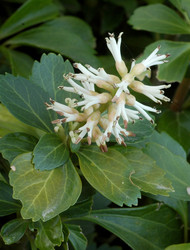
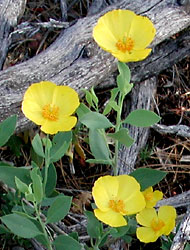
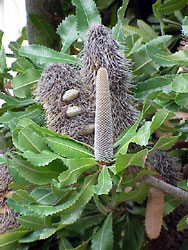
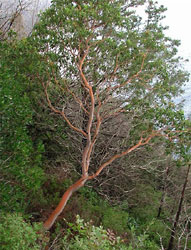





 Go to quick links
Go to quick search
Go to navigation for this section of the ToL site
Go to detailed links for the ToL site
Go to quick links
Go to quick search
Go to navigation for this section of the ToL site
Go to detailed links for the ToL site